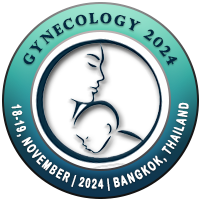
Vladimir Egorov
CEO of Advanced Tactile Imaging, Trenton, United StatesTitle: Biomechanical Integrity of the Female Pelvic Floor
Abstract
Introduction: The true etiology of pelvic diseased conditions
such as organ prolapse, urinary incontinence, vaginal tissue atrophy and
variations observed among individuals are not entirely understood. These
disorders are thought to share common pathogeneses, tissue elasticity changes,
weakening of the connective support tissues, and pelvic muscle dysfunction. Logically,
proposing a biomechanical assessment and characterization of the female pelvic
floor could give rise to important information in clinical practice.
Objective: To
develop and validate
a new integral parameter – the Biomechanical Integrity score (BI-score) - for the characterization of the female pelvic floor.
Methods: A
total of 253 subjects with normal and pelvic organ prolapse (POP) conditions
were included in the data analysis from multi-site observational, case-controlled
studies; 125 subjects had normal pelvic floor conditions, and 128 subjects had
POP stage II+. A Vaginal Tactile Imager (VTI) was used to acquire and calculate
automatically 52 biomechanical parameters for eight VTI test procedures (probe
insertion, elevation, rotation, Valsalva maneuver, voluntary muscle
contractions in two planes, relaxation, and reflex contraction). Statistical
methods were applied (t-test, boxplot, and correlation) to identify the
VTI parameters sensitive to the pelvic conditions and to establish the BI-score
components.
Results: Out
of 52 parameters, 26 were identified as statistically sensitive to the POP
development. These 26 parameters were subdivided into five groups, each of them
characterizing (1) tissue elasticity, (2) pelvic support, (3) pelvic muscle
contraction, (4) involuntary muscle relaxation, and (5) pelvic muscle mobility,
respectively. Every parameter was transformed to its standard deviation units against
the patient age similar to T-score for bone density. Linear combinations with
specified weights led to the composition of five component parameters for
groups (1)-(5) and the BI-score in standard deviation units. The p-value for the BI-score
has p = 4.3*10-31 for POP versus normal conditions. The POP diagnostic accuracy of the BI-score
was found as 89.7% versus POP-Q data. A reference
BI-score curve against age for normal pelvic floor conditions was defined (see
Figure 1).
Conclusions:
The proposed BI-score and its five components allow a comprehensive
biomechanical characterization of the female pelvic floor. Objectively
measurable transformations of the pelvic tissues, support structures, and
functions under different diseased conditions may be studied with the BI-score in
future research and practical applications.
Biography
Dr. Egorov is a scientist and entrepreneur
with primary area of focus in the women’s healthcare. He is a CEO of Advanced
Tactile Imaging, Inc. The company develops transvaginal biomechanical mapping
as an imaging and diagnostic tool to characterize the wide spectrum of pelvic
diseased conditions such as pelvic organ prolapse, incontinence, chronic pelvic
pain, pathologies which include endometriosis, adenomyosis and uterine
fibroids, cervical and ovarian cancer, and conditions leading to spontaneous
preterm delivery and predicting maternal birth trauma. He is a recipient of
multiple research grants from National Institutes of Health; conducted 13
clinical studies in the USA. He introduced a new integral parameter,
Biomechanical Integrity score (BI-score), for characterization of the female
pelvic floor. Objectively measurable transformations of pelvic tissues, support
structures, and functions under different diseased conditions may be quantified
with the BI-score relatively normal conditions. He has 82 research
publications, 29 patents and delivered numerous talks on national and
international scientific meetings. He received his Master of Science in
Biophysics at the Moscow Institute of Physics and Technology, and his PhD at
the Institute of Basic Biological Problems, Russia.

